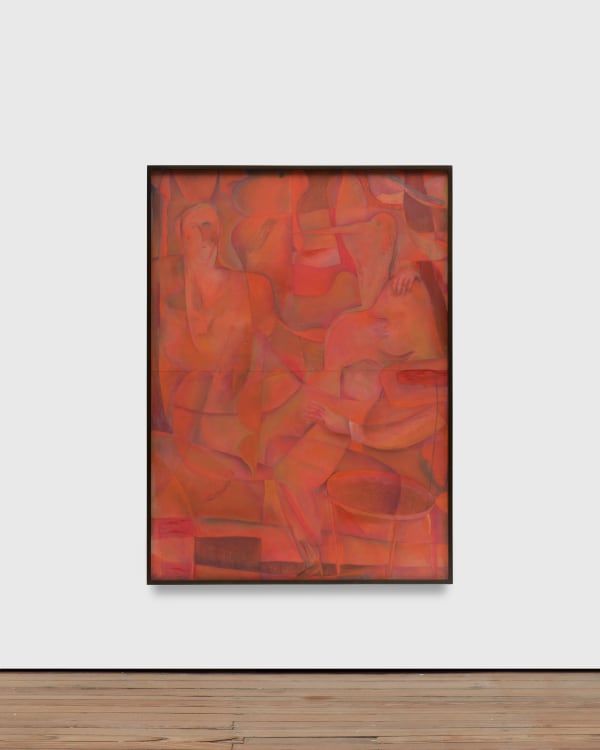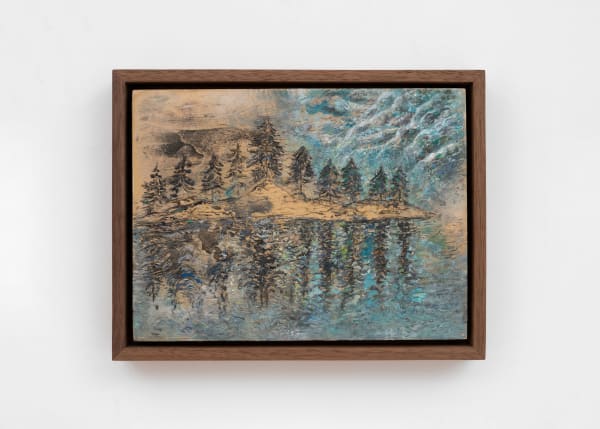The Garden of Earthly Delights
GRIMM is pleased to present a group exhibition in New York this summer inspired by the iconic painting The Garden of Earthly Delights (1490 - 1500) by Hieronymus Bosch.
Artists include: Sophie Birch, Gabriella Boyd, Anthony Cudahy, Sarah Esme Harrison, Volker Hüller, Hettie Inniss, Matthew Day Jackson, Jochem Mestriner, Francesca Mollett, Fischer Mustin, Ken D. Resseger, mosie romney, Kiki Xuebing Wang, Shiwen Wang, and Georg Wilson
The exhibition hinges around the ideas of natural beauty, pleasure, and our environment. Responding to the bucolic beauty of Eden, the surreal madness of hell, and the suspended time before man, this show invites viewers to explore the strange, layered world Bosch so masterfully created.
The Garden of Earthly Delights brings together a group of contemporary artists who reflect not only on nature’s forms but also the moments between the real and imagined. Some artists ruminate on the original work in the abstract, while others use known forms to connect these ideas to today.
Among the featured artists is Volker Hüller, who sees Bosch’s free-flowing, surreal figuration as deeply modern. “The figuration is so bizarre and imaginative that the underlying Christian symbolism recedes into the background,” Hüller says. “What’s striking is how this sense of creative freedom contrasts sharply with the painting’s unmistakable Renaissance craftsmanship. That tension is precisely what gives the work such a contemporary edge.” He adds, “Honestly, a bunch of flowers stuck in the ass of a figure has quite a potential to comment on the present—it’s surreal, absurd, and strangely fitting.”
Anthony Cudahy reflects on Bosch’s moralistic symbolism through a contemporary lens: “In the triptych, Bosch sets up so many consumption/defecation scenarios, culminating with the bird demon monster sitting on a throne in the right-most panel." "I'm interested in how the visionary art of a conservative true believer is now read as psychedelia with an entirely different set of associations.” Cudahy’s own contribution imagines a passive participant in a cycle of violence: “In my painting, the figure aloofly pushes along a spider to complete a sick chain of violence.”
Georg Wilson approaches Bosch with a sensitivity to color and atmosphere: “When I think of Bosch’s work I always first think of green, and therefore yellow,” Wilson explains. “There is the zingy apple-green of The Garden of Earthly Delights, dark sludge-green in his foliage and undergrowth, and most memorably the deep sea-green turquoise of his skies.” Drawing inspiration from a long-valued postcard of Saint Jerome, Wilson emphasizes how Bosch’s world-building influences her own: “His scenes of many figures conjure the idea of a whole world, of sorrow and joy and strangeness all taking place simultaneously... not the heroic main character narrative but something stranger, off to one side.”
The exhibition offers an opportunity to reengage with Bosch’s enigmatic vision in The Garden of Earthly Delights, as contemporary artists reinterpret his iconic triptych, transforming it into a site for critical reflection and contemporary discourse.
Sophie Birch's (b. 1992, Littlehampton, UK) translucent layers of oil paint create an atmospheric haze that evokes feelings of contemplation and fragility. Her work explores themes of transformation through soft, diffused abstraction.
Gabriella Boyd’s (b. 1988, Glasgow, UK) paintings aim to translate internal sensations into visual representations that capture the ephemeral nature of internal sensation and memory. Boyd’s work is akin to the shaky logic of dreams, where the boundaries between the body and the environment become unstable.
Anthony Cudahy (b. 1989, Fort Myers, FI, US) scours familial history and archival photography to create oil paintings that capture the gravity of everyday life through figures that seem simultaneously tethered to reality and dreamlike. His delicate rendering of the human figure provokes feelings of both intimacy and unease.
Sarah Esme Harrison (b. 1990, New York, NY, US) creates paintings that merge naturalistic forms with ornamental details, creating a contrast between bucolic chaos and man-imposed order. Harrison’s landscapes are framed by wrought iron embellishments that both confine and decorate the scenery behind them.
Volker Hüller’s (b. 1976, Forchheim, DE) work often dissembles figurative forms into abstract representations in a way that is evocative of the Cubist and Expressionist movements. The fragmented planes of his subject align in a rhythmic balance yet create a sense of friction and tension, contributing to the contemporary atmosphere of alienation and uncertainty in his work.
Hettie Inniss’s (b. 1999, London, UK) work responds to human sensory experience, preserving light, touch and memory in abstracted paintings that aim to capture the fleeting vestiges of memory. The radiant warm hues often featured in Inniss’ paintings imbue a sense of nostalgia for half-remembered spaces and sensations.
Matthew Day Jackson (b. 1974, Panorama City, CA, US) is a multi-media artist whose creations investigate the intersections between technology and nature. Jackson’s variety of both industrial and natural materials invites the viewer to examine humanity’s view of the environment.
Jochem Mestriner (b. 1998, Maastricht, NL) is a Dutch artist whose oil paintings often depict chimerical natural forms that invite the spectator to stimulate their imagination. Working in layers of diluted oil paint, Mestriner’s work probes the boundary between reality and fantasy.
Francesca Mollett’s (b. 1991, Bristol, UK) abstract paintings emulate aspects of the environment, hinting at naturalistic forms with fluid applications of paint. Composed with animated brush strokes and luminous colors, Mollet’s work draws from reality and transmogrifies the material into something intangible and ethereal.
Fischer Mustin’s (b. 1998, London, UK) work incorporates common Renaissance motifs, which he distorts through a surreal approach. His figures inhabit ambiguous, symbolic spaces where classical aesthetics merge with contemporary perspectives of the absurd.
Ken D. Resseger (b. 1981, Providence, RI, US) takes inspiration from the natural world to explore the human psyche. Through energetic, short brush strokes, Resseger infuses emotion into trees, rivers, and other natural elements, capturing both the physical and symbolic essence of nature.
mosie romney (b. 1994, New York, NY, US) uses screenshots, archetypes, symbols, and fictional characters in their practice to create a multidimensional world. They combine these elements to make visionary-like paintings, exploring the medium’s ability to act as a portal for self-perception, world-building, and to express the feeling of polychronic time.
Kiki Xuebing Wang (b. 1993, Zhengzhou, CN) uses translucent layers to capture natural forms reminiscent of stained glass. Her prismatic surfaces reflect and refract light, disrupting the viewer’s sense of spatial clarity. Wang’s paintings consider how the image itself distorts perception and memory.
Shiwen Wang (b. 1995, Shanghai, CN) reconciles the natural and the artificial through her paintings of organic imagery, reassembled with architectural geometries and spectral, refractive forms. Her work balances both disarray and order, creating paintings that are delicate, emphatic and inherently ambiguous.
Georg Wilson (b. 1998, London, UK) creates imagined landscapes that mythologize the earth’s environment. Drawing from folklore and ecology, her work invites the viewer to envision a world absent of humanity.
With special thanks to all participating artists and their representing galleries.






















































